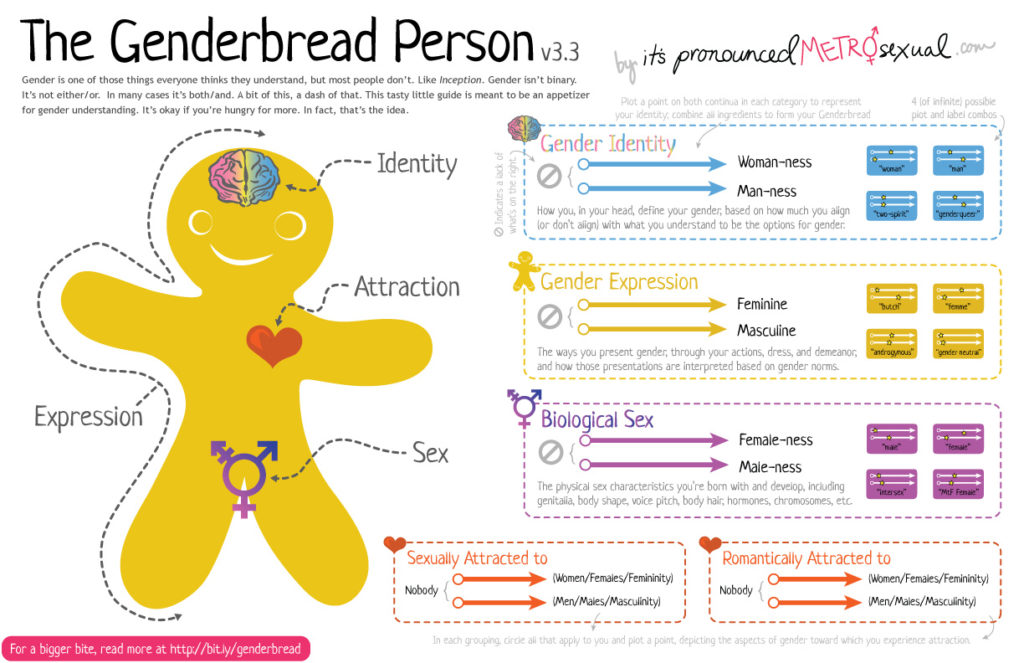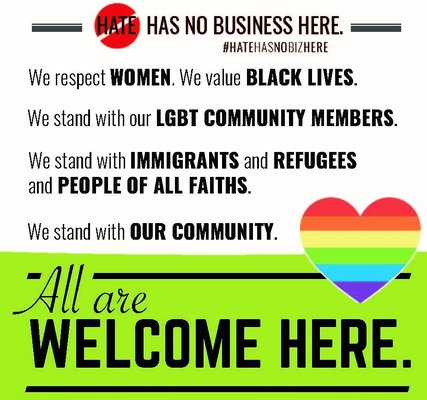Understanding Being Transgender: What to Know and What to Do

By: Ashley Carter Youngblood
Categories:
Understanding Being Transgender: What to Know and What to Do
June is National Pride Month! So, I figured I would start the month off with some pride talking about a topic that has been getting a lot of press lately: being transgender. This topic can be confusing to some. So, let’s start off with some definitions (although this is NOT a comprehensive list and resources like The National Center for Gender Equality can be a great place to get a complete list of related terms):
“Transgender” – A term for those who feel their gender is not congruent with their biological sex assigned at birth (e.g. a person born with a penis feels like a woman).
“Gender Identity” – One’s sense of experiencing a gender (e.g. “maleness,” “femaleness”). This is not visible to others as it is a personal experience of an individual, regardless of outward expression or reproductive organs.
“Gender Expression” – Often reflective of one’s gender identity, this is the way in which people outwardly display their gender to others (e.g. via dress, hairstyle, etc.).
“Transsexual” – An outdated term for describing those whose gender identity is different from their sex assigned at birth.
“Cross-dresser”/”Transvestite” – An older term (perceived a derogatory by many) that represents those who enjoy dressing as the other gender but who do not feel as if they are the other gender.
“Drag King”/”Drag Queen” – A performer who dresses at events as their opposite gender in order to provide entertainment to others. Although it can reflect a person’s gender identity or expression, it does not necessarily.
“Gender Non-conforming”/”Non-binary”/”Genderqueer” – Terms used to describe when an individual doesn’t view themselves as entirely “male” or “female” and, therefore, has a different gender expression than traditional societal expectations.
“Bi-gendered” – Those whose gender identity includes experiences of both genders and may feel the strength of one expression is stronger at certain times (e.g. feels more “male” today and more “female” next week).
“Transgender Male”/”FTM” – A transgender male or someone who has had a Female To Male (FTM) transition is a person who identifies as male, regardless of sex assigned at birth or reproductive organs; often desires to be referred to as male (e.g. using masculine pronouns such as “he” and “him”).
“Transgender Female”/”MTF” – A transgender female or someone who has had a Male To Female (MTF) transition is a person who identifies as female, regardless of sex assigned at birth or reproductive organs; often desires to be referred to as female (e.g. using feminine pronouns such as “she” and “her”).
“Intersex” – A result of a unique arrangement of genes that causes a person to be born with either both reproductive organs (e.g. penis and vagina/clitoris) or a pattern of anatomy that is not specifically “male” or “female.”
“Sexual Orientation” – A term describing to whom a person is attracted to or falls in love with (e.g. homosexual, heterosexual, gay, lesbian, bisexual). Separate from gender identity or expression.

(If you’re still confused, my friend the “The Genderbread Person” here may be able to help you out. They help to clarify the differences between all of these aspects of someone’s experience.)
Phew! I haven’t even started writing this blog and I hope I haven’t lost you yet! Hang in there because, here’s the thing: gender, like sexuality, is experienced on a spectrum. Alfred Kinsey’s famous research in 1948, which you can find referenced to here, helps remind us that any one person can be any mix of these things. This is what is so beautiful (and I think is also what can be so confusing) about being transgender: it breaks the mold for what we think a “man” or “woman” should be like. Heck, it even takes into question how we identify even what a “man” or “woman” is in the first place!
There is a wonderful book called Galileo’s Middle Finger that helps to illustrate the fluidity of the experience of gender (remember: sexual orientation is a different thing!). I highly recommend it! But, I think part of the “challenge” of being transgender, in addition to people having a hard time understanding it who haven’t experienced it, is that people don’t know how to react.
The Simple Solution
I have and continue to work with many individuals, couples, and families related to having a transgender loved on in their life. Depending on political views, religious beliefs, culture, and other factors, people have varying degrees of receptivity. But, with all of the questions you have, here is a way to simplify the ENTIRE process of knowing what to do:
Simply love someone the way they want to be loved.
What do I mean by this? If your best friend wanted to start going by the nickname “DJ” when you have known them all their life as “Donald James,” would you be offended? If your young daughter wanted to get down and dirty with other motocross racers instead of wearing pink frilly dresses, would you refuse to let her do something she loves?
Shakespeare said it best when he asked in Romeo and Juliet “What’s in a name?” So much of the time we get caught up in trying to conceptualize someone else’s gender identity or expression when, if they have come out to us, they are simply asking them to love them in the way they want to be loved.
You want me to call you “DJ?” Great! You want to compete with all boys in motocross rallies? Wonderful! You’re realizing that you identify more as “male” and want me to call you “Jack” and use male pronouns instead of your birthname of “Julie?” Okay!
What Gender is Really About
In my clinical experience, for those who struggle with responding to a loved one who has come out to them as transgender, any discomfort tends to reflect more about the listener’s discomfort with blurring the lines between what they thing “male” and what is clearly “female.” But, if we think about this, does this even make sense? Have you ever met a “traditional,” burly “man” who wasn’t sensitive or maybe happened to like crocheting? Or, are you a woman who loves high heels and makeup, but also likes to box and work on cars? If either of those things were true for this “man” and this “woman,” would that make them less “female” or “male”? Or, would that just happen to be who they are?
And, THAT is just want those who transgender are – themselves. Sometimes it takes us a while to really find ourselves. This can be true for those who are transgender, too. But, when working with loved ones of those who are transgender, I think it’s important to ask the following question: If you felt trapped in a body that didn’t “feel right” to you and you were expected to live your life checking a gender box (often times literally on physical documents) in a certain way, never truly being able to be yourself, how would YOU feel? How hard would that be for you? Would you want others to make a big deal about it or would you simply want to be loved and referred to (e.g. pronouns) in a way that lifts your heart and felt “right?”

Two Caveats
I offer two warnings, however. The first is that, because each of our experiences with being human, like the experience of being “male,” “female,” or something in between, is so unique, this blog is only the tip of the iceberg. There are those who identify as Asexual or Non-Gendered. There are those who, by definition, may be a transgender female but do not identify as “transgender” as they experience themselves as fully “female.”
Second, “transgender” also means a host of things to all different people. There are those who identify as transgender when we may not be able to “detect” this just by interacting with them. There are those who identify as “transgender” even when they have had no hormones, surgery, and tend to continue to dress more congruent with the sex they were assigned at birth. There is no “right” or “wrong” way to be transgender (again, just like being human). So, we may not be able to fully understand someone’s journey with their gender, no matter how young they are. And, that’s okay. Again, supporting a loved one who is transgender is nothing more than loving them in the way they want to be loved – whether a gender, name, pronouns, or reflective of some other component.
In the end, as our parents may have taught us: We can’t judge a book by its cover. And, we shouldn’t. Even if we are struggling with a loved one who has come out to us or who we believe may be transgender, we can use the time to explore our own beliefs of what gender means to us and how we attempt to “measure” something that is a unique and individual experience.
I think the best example of this is from the work I have done with families who have a loved one who is transgender. In my experience, it is not the children’s peers, especially if they are very young, that have any problem. In fact, rarely do they bat an eye if their friend wants to wear something new or be called something new. Instead, it’s us, as adults, who are uncomfortable.
What does this say about us, as adults, that kids can catch on and simply love someone the way they want to be loved better than us? How does this reflect more about our anxieties of something (i.e. how we define gender) that we have kept in a certain box for many decades? I realize this is a loaded question. And, such a transition is rarely easy for anyone involved. So, be sensitive. Ask questions. Gather resources. If all else fails, reach out to a professional, like a therapist, who is well-versed in the spectrum of the gender and sexual orientation can help you to better understand and navigate such changes.
~Ashley Carter Youngblood, LMSW, LMFT, CADC, ADS, CMHIMP
 Ashley Carter Youngblood is a licensed Clinical Social Worker, licensed Marriage and Family Therapist, and a Certified Mental Health Integrative Medicine Provider who has been in the field since 2007. She offers counseling at her woman-owned business, Inner Peace Counseling, PLC, for those in Kalamazoo, Portage, Mattawan, Battle Creek, Paw Paw, and the surrounding areas of Southwest Michigan. She is passionate about her work with clients, whether it’s providing individual counseling, couples counseling, family therapy, life coaching. And, she has much experience and greatly enjoys working with members of the LGBTQIA+ populations and their loved ones. Her specialties include holistic healing/mindfulness, counseling for women, anxiety, couples counseling, and addictions/substance abuse.
Ashley Carter Youngblood is a licensed Clinical Social Worker, licensed Marriage and Family Therapist, and a Certified Mental Health Integrative Medicine Provider who has been in the field since 2007. She offers counseling at her woman-owned business, Inner Peace Counseling, PLC, for those in Kalamazoo, Portage, Mattawan, Battle Creek, Paw Paw, and the surrounding areas of Southwest Michigan. She is passionate about her work with clients, whether it’s providing individual counseling, couples counseling, family therapy, life coaching. And, she has much experience and greatly enjoys working with members of the LGBTQIA+ populations and their loved ones. Her specialties include holistic healing/mindfulness, counseling for women, anxiety, couples counseling, and addictions/substance abuse.
I welcome you to contact me or leave any questions or feedback you have about this post. Please keep in mind that the above information is the opinion of an individual, should not be considered medical advice/treatment, and is for entertainment/educational purposes only. I write these blogs as an expression of my passion for wellness and with the hope to be able to help as many people as possible. So, for more information about how to safely navigate this website and to what terms you are agreeing upon use, visit my Disclaimer page. And, as always, if you are experiencing an emergency, contact 911 or present yourself to your nearest emergency room.
Thanks for reading.
